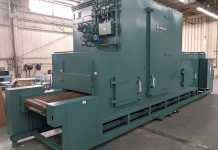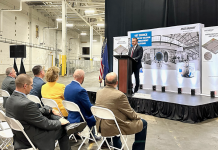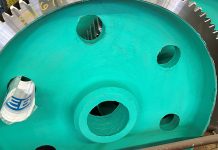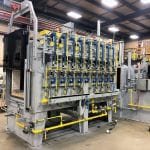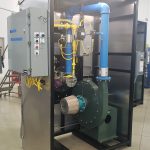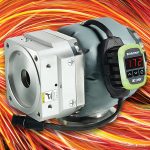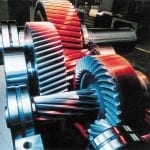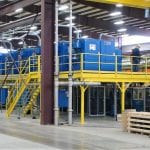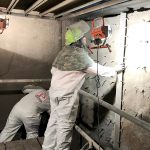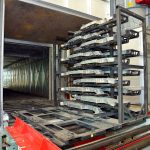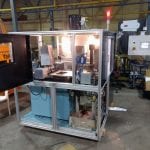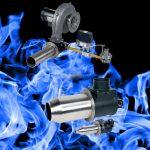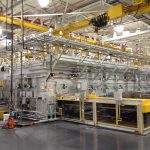To get accurate temperature measurements when thermal processing materials, the common practice is to use infrared sensors; however, those sensors often cannot pinpoint specific, crucial areas of a sample that may be problematic and need further characterization.
After years of research, the experts behind Laser Thermal have developed a method to measure the thermal properties of a material with a non-contact thermal conductivity measurement tool using optical technologies.
“The equipment we sell measures the thermal properties of materials; when anything changes in a material based on processing like heat treatment, the morphology, structure, or phase of the material often changes in such a way where the thermal conductivity changes,” said Patrick Hopkins, CSO and co-founder of Laser Thermal. “So, the equipment that we manufacture and the testing that we do serves two purposes: One is to tell you what the thermal conductivity of the material is — that’s primarily how the technique and company was born. The second is to tell you that something has changed in the processing from your parent material. This is often used as more of a quality control metric rather than as an absolute measurement.”
Non-contact optical technique
When a material is processed, Laser Thermal’s non-contact optical technique can detect changes, whether that is in the microstructure, grain size, orientations, or chemistry, for example, according to Hopkins.
“The technique that we utilize is a way to sense that something has changed during processing and relate that back to the thermal processes and the temperature of the sample,” he said.
The technology developed by Laser Thermal is optical, according to John Gaskins, CEO and co-founder.
“It’s based on lasers; we use lasers to measure the temperature changes on the surface of the sample, and we can relate temperature changes to thermal properties,” he said. “If anything changes in the material that will change its ability to conduct heat, we can sense that. And it’s an all-optical technique that can be used to detect material changes with resolution from the nanoscale to the macroscale, and, additionally, it’s fully automated. It’s a way that we can do high throughput material screening of processed materials.”
Although Laser Thermal’s technique serves a similar function as pyrometry, the measurement principle is fundamentally different, according to Gaskins.
“It’s in the same realm as pyrometry in that we are sensing temperature changes, but it’s an optical technique in that we look at reflectivity,” he said. “We’re not looking at thermal emission; we don’t rely on needing to know emissivity or surface finish. It’s looking at the changes in reflectivity of the sample surface. Pyrometry is primarily just sensing the emissivity of material.”
Creating a new product
The measuring technology offered by Laser Thermal stems from the company’s zeal to embrace new advances in optical technologies in order to create new products, according to Hopkins.
“One of the things that we have emphasized as a company is that there are a lot of contact measurements for thermal properties, and there are a lot of non-contact measurements for temperature, but there are almost no commercially available non-contact measurements other than maybe laser flash for thermal conductivity,” he said. “One of the things that we are always looking to do is to continue to innovate to create thermal measurement technologies that are useful for our customers.”
This is particularly useful for processes involving high temperatures where it is essential to monitor microstructural evolution as materials go from molten to solid phases during quenching, giving customers the needed information about what happens to their materials during the manufacturing process, according to Hopkins.
Unlike pyrometry and macroscopic techniques, Laser Thermal can interrogate localized changes in material microstructure in a non-contact manner, Hopkins said, including when materials are melting or going through other phase transitions.
“We can, for example, interrogate very specific regions of a sample that may get very hot and melt as opposed to looking at the entire block of material,” he said. “We have resolution that can be on the order of, or less than, a grain size and see how the thermal properties of those isolated regions are changing.”
Beyond traditional metrology
This allows for a level of resolution both in terms of time and space that isn’t possible with traditional metrologies, according to Gaskins.
“We have this spatial resolution that can be on the order of microns, which basically means that you can combine the advantages of pyrometry where you’re looking at overall hotspots and temperature change, with some flavor of microscopy, and that you can now interrogate locally how different regions are changing as they’re going through a heat-treated process,” he said. “Given that it is non-contact, we have the ability of monitoring materials as they’re changing both in-situ and post treatment, but really it’s the real time and automated aspect that allows you to do high-throughput material testing. Our techniques don’t need to know anything about the material as it’s going through the heat-treat process. We can, in real time with very high throughput, interrogate the material’s response with resolution on the order of microns to millimeters.”
Laser Thermal’s mission is to manufacture and supply its microscope measuring systems to laboratories and companies that need them, but Laser Thermal has the ability to accept outside samples and measure them in house as well, according to Hopkins.
“People can send us samples, but we’re manufacturing microscopes; we’re manufacturing equipment that we sell and deliver as a standalone measurement tool in people’s labs or in manufacturing lines,” he said. “However, we have customers who don’t have a need for a full system, and so they’ll just send us materials for testing.”
Game-changing equipment
What Laser Thermal can offer the heat-treat industry is still a relatively new process, and both Gaskins and Hopkins recognize that their technology could be a significant game changer for the companies in need of high-quality, detailed thermal measurements.
“A large contingent of our customer base lives in the semiconductor metrology space,” Gaskins said. “But as we’ve begun to roll out more on the high-temperature side of things, it has certainly become relevant to heat treating. Even inside the semiconductor electronics market, there are all sorts of different anneals and heat treatments that are going on that oftentimes are causing things to react with each other — causing microstructures, phases, and compositions to change on scales that have not been able to be interrogated up to this point. And there’s no real knowledge of what those impacts are on heat transfer. We’ve also seen, as we’ve begun to offer high-temperature testing, that our customers are just interested in understanding things like: ‘When I do take a material to temperature, what are the thermal properties at temperature?’ Because that directly relates to how the microstructure’s going to evolve, how that part is going to come out, or being able to model and understand how long a part has to be at a certain temperature before it evolves into the phase needed.”
Young company — years
of research
Laser Thermal officially began as a company in 2020, but its roots go back at least 10 years when Gaskins and Hopkins were developing thermal conductivity measurement tools for materials at the University of Virginia, according to Hopkins.
“Our expertise was in methods and measurement of temperature and thermal properties of materials to try to evaluate how microstructure and processing would impact thermal properties,” he said. “In 2015, we developed a technique and filed for a patent on a way to make a very streamlined non-contact thermal conductivity measurement tool.”
Five years later, Laser Thermal was born — a company based on contract testing and developing equipment for thermal conductivity measurement systems.
“Since 2020, we’ve been manufacturing and selling thermal conductivity measurement systems and doing service contract measurements of thermal conductivity of materials,” Hopkins said.
It’s been a particular point of pride, according to Hopkins, to have been able to evolve the company from its research development to full commercialization in such a short time.
“Being able to disseminate that tool to a wider community took a real advance in understanding and in engineering to be able to create this tool that you can put into industry, into academia, and into research labs outside of the specialty lab,” he said. “A really big achievement was spinning out the company to actually get this equipment and these microscopes that we sell out into the field and out into the public. That really is exciting to see.”
Old problems, new solutions
Because Laser Thermal is bringing to the industry a new and innovative way to measure thermal processing, oftentimes Gaskins said they are solving problems that customers have had for a while with no solution in sight.
“Usually our approach toward that is, if it’s material measurement or maybe a slightly different variation on what we normally do, usually our methodology is to say, ‘send it to us,’” he said. “We’ll do a little bit of interrogation, and then if there’s a solution for this problem, then we can work together to understand whether it’s a consistent materials-testing relationship or whether there’s enough interest there to create some modification on what our standard tools are.”
That sort of arrangement often can bring about a co-development idea between Laser Thermal and a client, according to Gaskins.
As the industry learns of what Laser Thermal can offer, Hopkins expects more companies to express interest in the innovative technology.
“For us, the relevance is in creating metrologies that inform companies about high-temperature properties — via what are typically difficult measurements — to facilitate an understanding of properties at high temperatures, understanding properties through melt, and understanding properties in the liquid phase, because that has a whole implication on different products and how castings are formed,” he said. “For us, high temperature is probably the place in the thermal market where we’re going to place the biggest emphasis on product development. In 10 years’ time, I imagine that will be where we’ll have the largest impact on the thermal processing market.”
More info aserthermal.com










